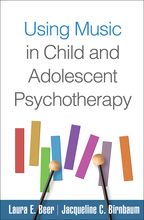Using Music in Child and Adolescent Psychotherapy
Laura E. Beer and Jacqueline C. Birnbaum
HardcoverPaperbacke-bookprint + e-book
Hardcover
orderMarch 13, 2019
ISBN 9781462539154
Price: $57.00 200 Pages
Size: 6" x 9"
Paperback
orderMarch 27, 2019
ISBN 9781462539147
Price: $38.00200 Pages
Size: 6" x 9"
There is growing evidence for the powerful role that music plays in enhancing children's cognitive, social, and emotional development. Written for a broad audience of mental health professionals, this is the first book to provide accessible ways of integrating music into clinical work with children and adolescents. Rich case vignettes show how to use singing, drumming, listening to music, and many other strategies to connect with hard-to-reach children, promote self-regulation, and create opportunities for change. The book offers detailed guidelines for addressing different clinical challenges, including attachment difficulties, trauma, and behavioral, emotional, and communication problems. Each chapter concludes with concrete recommendations for practice; an appendix presents a photographic inventory of recommended instruments.
This title is part of the Creative Arts and Play Therapy series, edited by Cathy A. Malchiodi and David A. Crenshaw.
“Beer and Birnbaum provide a new understanding of how music can be integrated into psychotherapy. Drawing on theory, scientific literature, and clinical observations, the authors describe the profound and convincing impact of music on clinical trajectories. The book shows how music offers an opportunity for children and adolescents to gain awareness of and express intense emotions in a safe therapeutic context. This well-organized volume presents a strong rationale for bridging music therapy and psychotherapy.”
—Stephen W. Porges, PhD, Distinguished University Scientist, Kinsey Institute, Indiana University
“This much-needed resource offers indispensable information that will reduce the guesswork that comes along with including music in therapy. Beer and Birnbaum give the reader practical advice regarding room setup, instrument choices, and sources for recordings, and illustrate simple yet powerful ways that music can facilitate the therapeutic process. Recommendations for practice at the end of each chapter provide appropriate suggestions that can be adjusted to accommodate the clinician’s knowledge and experience as a music-maker.”
—Carol Ann Blank, PhD, LCAT, LPC, MT-BC, Manager of Research and Special Needs Services, Music Together
“This book offers a clear theoretical rationale, clinical guidelines, and practice applications for incorporating music into child and adolescent psychotherapy. Using music can be tremendously helpful for less verbal clients and refreshing for those who are more communicative. The book helps mental health providers think outside the box of our usual talk therapy strategies in order to engage clients in new and creative ways. A 'must' for practitioners and students!”
—Guy S. Diamond, PhD, Director, Center for Family Intervention Science, Drexel University
“Music has the power to engage the mind and body in ways that are immediate and intrinsically life enhancing. Well-informed summaries of the academic literature, engaging clinical vignettes, and many straightforward recommendations for practice will benefit therapists who want to bring music into their work with children.”
—Stephen Malloch, PhD, Honorary Fellow, Westmead Psychotherapy Program, University of Sydney, Australia; Adjunct Fellow, MARCS Institute for Brain, Behaviour, and Development, Western Sydney University
Table of Contents
1. Music as a Therapeutic Intervention2. Getting Started
Appendix 2.1: Suggested Instruments and Equipment
3. Working with Music as an Agent of Change
4. Music in Child Development
5. Attachment and Attunement in Interpersonal Relationships
6. Trauma and Resilience
7. Children with Behavioral, Emotional, and Communication Disorders
Postscript
References
Index
About the Authors
Laura E. Beer, PhD, MT-BC, is a board-certified music therapist and Associate Professor and Director of the Music Therapy Program at Maryville University. Since 1988, she has worked in many different settings with children with developmental and psychiatric issues, and with infants in neonatal intensive care units, as well as with older adults and patients in hospice care. Dr. Beer has published on the creative use of music in research and therapy, presented internationally, and facilitated numerous trainings for caregivers for people with advanced dementia. She has received recognition for professional practice and for being a changemaker and advocate for music therapy licensure. Dr. Beer serves as Editor-in-Chief of one of the two national peer-reviewed music therapy journals, Music Therapy Perspectives.Jacqueline C. Birnbaum, MSEd, MA, MT-BC, LCAT, is an early childhood educator, board-certified music therapist, and licensed creative arts therapist. She began her music therapy work in the 1980s in schools for children with communication and other challenges, developing and implementing music therapy programs. Ms. Birnbaum is Administrative Coordinator and Senior Clinician at the Nordoff–Robbins Center for Music Therapy at New York University. She has presented internationally on the use of creative music therapy; is a pianist, guitarist, violinist, composer, and author of published songs for therapy; and is the author of an e-book that includes video examples of her clinical work with a traumatized child. Ms. Birnbaum has served as Chairperson of the Certification Board for Music Therapists.
